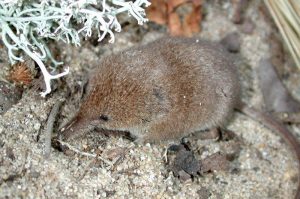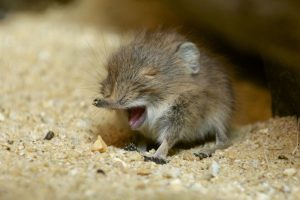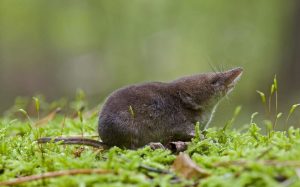Arctic Shrew
Arctic shrews can be found in the northern US and through most of Canada. Their populations are abundant through most of their range, thus negating the risk of extinction.
Scientific Classification
| Kingdom | Animalia |
| Phylum | Chordata |
| Class | Mammalia |
| Order | Eulipotyphla |
| Family | Soricidae |
| Genus | Sorex |
| Scientific Name | Sorex arcticus |
Quick Information
| Also known as | Blackback shrew, Saddlebacked shrew, musaraigne arctique (French) |
| Description | Size: 3.94-4.92 in (100-125 mm) Weight: 0.19-0.48 oz (5.3-13.5 g) Color: They have tri-colored fur, most visible during winter; dark brown on the dorsal side from the head to the tail, light brown on the sides, and the belly is graying brown; the tail is dark brown dorsally while the ventral side is light brown; they molt twice a year, the winter pelage is brighter and denser, while in summer it is pale and loosely packed |
| Subspecies |
|
| Distribution | From the Arctic Circle in the north to the Northern United States |
| Habitat | Mostly found near water bodies like streams, marshes, lakes, wetlands, and swamps; can also be seen in tamarack and spruce swamps, boreal forests, mixed conifer swamps, old or dry fields, mixed grasses, alder thickets, forbs, sedge hammocks, willow, and cattail shrubs |
| Sounds & Communication | Mostly through touch, smell, and sounds; they can make and hear high pitched sounds |
| Lifespan | Around 18 months in the wild |
| Diet | Insects and invertebrates; larch sawflies are a major portion of their diet |
| Adaptations | Their fur coloration helps them stay camouflaged and hidden from predators; a common defense mechanism for shrews (including this species) is the secretion of a musky odor from its sides |
| Predators | Great-horned owls |
| IUCN Conservation Status | Least Concern |
Behavior
- Arctic shrews lead a solitary lifestyle.
- They are active both during the day and the night. When they rest they lie on the ground either on a side or their ventral surface on the ground, rolling their body up with the head tucked into it.
- They become territorial when they attain adulthood.
Mating & Reproduction
Despite limited information on the mating habits of Arctic shrews, it can be safely inferred that theirs’ is similar to that of other shrew species. Females have 1 or 2 litter each year, each consisting of 4-10 offspring. The gestation period ranges between 13 and 21 days.
Life-cycle
The young are nursed until they are around 20-24 days old. They reach sexual maturity after one year.
Interesting Facts
- They are voracious eaters, having to eat constantly because of their quick metabolism.
- The maritime shrew and the tundra shrew were both considered subspecies of the Arctic shrew, but each has been assigned their individual species since.
- An anthropomorphic Arctic shrew can be seen in the 2016 Walt Disney animated film, Zootopia. Its name is Mr. Big in the movie.
References:
Published on May 31st 2018 by Sudipto Chakrabarti under Coniferous Forest Animals.
Article was last reviewed on 5th December 2024.





